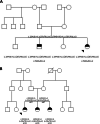Two novel mutations in the DNAH11 gene in primary ciliary dyskinesia (CILD7) with considerable variety in the clinical and beating cilia phenotype
- PMID: 33243178
- PMCID: PMC7690114
- DOI: 10.1186/s12881-020-01171-2
Two novel mutations in the DNAH11 gene in primary ciliary dyskinesia (CILD7) with considerable variety in the clinical and beating cilia phenotype
Abstract
Background: Diagnosis of primary ciliary dyskinesia (PCD) still remains a challenge, especially with mutations in the Dynein Arm Heavy Chain 11 (DNAH11) gene. Classical diagnostic measures like Transmission Electron Microscopy (TEM) are not applicable for mutations in the DNAH11 gene since ultrastructural defects of the ciliary apparatus are absent. Novel mutations encoding for PCD appear all the time with considerable variation in the clinical picture, making it necessary to update data bases and guidelines for PCD diagnostics.
Methods: In this study we examined two unrelated, Finnish families with symptoms of PCD applying the clinical scoring system: Primary ciliary dyskinesia Rule (PICADAR), high speed video microscopy analysis (HSVMA) for ciliary movement, a commercially available gene panel analysis and nasal Nitric Oxide (nNO) measurements if applicable.
Results: Two, likely pathogenic variants in the DNAH11 gene (c.2341G > A, p. (Glu781Lys) ja c.7645 + 5G > A) were detected. In the first family, compound heterozygous mutations led to disease manifestation in two of 4 children, which showed a similar phenotype of cilia beating pattern but marked differences in disease severity. In the second family, all three children were homozygotes for the c.2341G > A p.(Glu781Lys) mutation and showed a similar degree of disease severity. However, the phenotype of cilia beating pattern was different ranging from stiff, static cilia to a hyperkinetic movement in one of these children.
Conclusions: In this study we describe two Finnish families with PCD, revealing two novel mutations in the DNAH11 gene which show considerable variety in the clinical and beating cilia phenotype. The results of this study show the clinician that PCD can be much milder than generally expected and diagnosis demands a combination of measures which are only successful in experienced hands. Chronic and repeatedly treated wet cough should raise suspicion of PCD, referring the patient for further diagnostics to a specialised PCD centre.
Keywords: Combined diagnostics; Compound heterozygosity; DNAH11 gene; Mild disease; PCD; PICADAR.
Conflict of interest statement
The authors of this article have no conflict of interest concerning this publication.
Figures

Similar articles
-
Mutations of DNAH11 in patients with primary ciliary dyskinesia with normal ciliary ultrastructure.Thorax. 2012 May;67(5):433-41. doi: 10.1136/thoraxjnl-2011-200301. Epub 2011 Dec 18. Thorax. 2012. PMID: 22184204 Free PMC article.
-
Deep phenotyping, including quantitative ciliary beating parameters, and extensive genotyping in primary ciliary dyskinesia.J Med Genet. 2020 Apr;57(4):237-244. doi: 10.1136/jmedgenet-2019-106424. Epub 2019 Nov 26. J Med Genet. 2020. PMID: 31772028
-
DNAH11 Localization in the Proximal Region of Respiratory Cilia Defines Distinct Outer Dynein Arm Complexes.Am J Respir Cell Mol Biol. 2016 Aug;55(2):213-24. doi: 10.1165/rcmb.2015-0353OC. Am J Respir Cell Mol Biol. 2016. PMID: 26909801 Free PMC article.
-
Ciliary defects and genetics of primary ciliary dyskinesia.Paediatr Respir Rev. 2009 Jun;10(2):51-4. doi: 10.1016/j.prrv.2009.02.001. Epub 2009 Apr 18. Paediatr Respir Rev. 2009. PMID: 19410201 Review.
-
Value of transmission electron microscopy for primary ciliary dyskinesia diagnosis in the era of molecular medicine: Genetic defects with normal and non-diagnostic ciliary ultrastructure.Ultrastruct Pathol. 2017 Nov-Dec;41(6):373-385. doi: 10.1080/01913123.2017.1362088. Epub 2017 Sep 15. Ultrastruct Pathol. 2017. PMID: 28915070 Free PMC article. Review.
Cited by
-
Role of Nasal Nitric Oxide in Primary Ciliary Dyskinesia and Other Respiratory Conditions in Children.Int J Mol Sci. 2023 Nov 10;24(22):16159. doi: 10.3390/ijms242216159. Int J Mol Sci. 2023. PMID: 38003348 Free PMC article. Review.
-
Whole-exome sequencing reveals genetic variants that may play a role in neurocytomas.J Neurooncol. 2024 Feb;166(3):471-483. doi: 10.1007/s11060-024-04567-9. Epub 2024 Feb 6. J Neurooncol. 2024. PMID: 38319496
-
Transcriptome Analysis in Air-Liquid Interface Porcine Respiratory Epithelial Cell Cultures Reveals That the Betacoronavirus Porcine Encephalomyelitis Hemagglutinating Virus Induces a Robust Interferon Response to Infection.Viruses. 2024 Jun 11;16(6):939. doi: 10.3390/v16060939. Viruses. 2024. PMID: 38932231 Free PMC article.
-
DNAH11 and a Novel Genetic Variant Associated with Situs Inversus: A Case Report and Review of the Literature.Case Rep Med. 2023 Apr 25;2023:8436715. doi: 10.1155/2023/8436715. eCollection 2023. Case Rep Med. 2023. PMID: 37153356 Free PMC article.
-
Transmission disequilibrium analysis of whole genome data in childhood-onset systemic lupus erythematosus.Genes Immun. 2023 Aug;24(4):200-206. doi: 10.1038/s41435-023-00214-x. Epub 2023 Jul 24. Genes Immun. 2023. PMID: 37488248 Free PMC article.
References
MeSH terms
Substances
LinkOut - more resources
Full Text Sources

